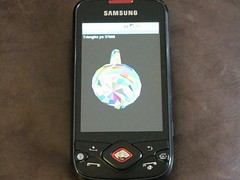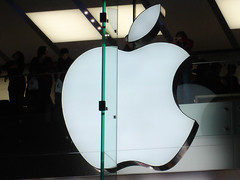Think of it as the opening act at a concert: Nokia, Motorola and Amazon are expected to unveil new mobile devices this week before attention turns to a new iPhone and possibly a smaller iPad from Apple.
Makers of consumer electronics are refreshing their products for the holiday shopping season. Apple's rivals are hoping that a head start on the buzz will translate into stronger sales. Nokia and Microsoft, in particular, are trying to generate interest in a new Windows operating system out next month.
Apple dominates the market for tablet computers. Seven out of every 10 tablets shipped in the second quarter were iPads, according to research firm IHS iSuppli. Rivals have been trying to compete with smaller, cheaper models -- such as the Kindle Fire, which Amazon is expected to update on Thursday. Now, there's speculation that Apple will be coming out with a smaller iPad as well.
Sales of Apple's iPhones are still strong, though the company lost the lead in smartphones to Samsung this year. Samsung Electronics benefited from having its Galaxy S III out in the U.S. in June, while Apple was still selling an iPhone model released last October. A new iPhone is expected as early as this month, allowing Apple to recapture the attention and the revenue.
Here's a look at what to expect this fall:
-- NEW IPHONE: Apple has been coming out with a new iPhone each year, and that's likely to continue. The new model is expected to work with fourth-generation, or 4G, cellular networks that phone companies have been building. That capability is something the S III and many other iPhone rivals already have. A bigger iPhone screen is also possible. Apple said Tuesday that it will host an event in San Francisco next Wednesday. The topic wasn't disclosed, but the email invitation contains a shadow in the shape of a "5" -- a sign that the iPhone 5 is coming. Sales usually begin a week or two after such an announcement. One thing is known: Apple plans to update its phone software this fall and will ditch Google's mapping service for its own.
-- SMALLER IPAD: Apple has done well selling its full-sized tablet computer, which has a screen that measures nearly 10 inches diagonally. Many companies have tried to come out with iPad alternatives, but the ones that have had moderate success have tended to be those with smaller, 7-inch screens and lower price tags. There's a belief that Apple will come out with mini iPad this fall -- possibly with a 7.85-inch screen -- to compete with those competitors. It's not as much a certainty as a new iPhone, though. Apple hasn't said anything about its plans.
-- REKINDLING THE FIRE: Amazon.com's 7-inch Kindle Fire is one of the smaller tablets with decent sales. Last week, Amazon said it has sold out of the Kindle Fire, a sign that it had retooled its production lines for a successor. Amazon has a major event planned in Santa Monica, Calif., on Thursday. Amazon hasn't said anything about what it will say, but it's expected to announce a new Kindle Fire and possibly other Kindle e-readers, too. Barnes and Noble Inc., which makes the 7-inch Nook Tablet, may have an update this fall as well.
-- MOTOROLA'S RETURN: Though it's a pioneer in the cellphone industry, Motorola hasn't had a hit since the Razr phone came out in 2004. Under new owner Google Inc., Motorola Mobility is trying to change that. It has scheduled an event in New York on Wednesday. No further details were available. It could be a new phone or a new tablet running Google's Android operating system. Either way, it will be the first Motorola product announcement since Google bought the company for $12.4 billion in May. Google, meanwhile, continues to sell a 7-inch Android tablet, the Nexus 7, made in partnership with AsusTek Computer Inc.
-- CALLING ON WINDOWS: Microsoft will release a new version of the Windows operating system on Oct. 26, one that's designed to work on both traditional computers and tablet devices. A new version of the Windows Phone system is coming out, too. Once-dominant phone maker Nokia has been struggling in the shadow of Apple, and it's counting on the new Windows system for a revival. Nokia and Microsoft have jointly scheduled an announcement in New York on Wednesday. It's likely on new Windows phones under Nokia's Lumia brand.
-- SURFACE: Microsoft plans its own tablet computer, too. It's new territory for Microsoft, which typically leaves it to others to make devices using its software. Now, it will be competing against its partners. The Surface tablet will come in two versions, both with 10.6-inch screens, slightly larger than the iPad's. One model will run on phone-style chips, just like the iPad, and will be sold for a similar price. A heavier, more expensive version will run on Intel chips and be capable of running standard Windows applications. The Surface will go on sale on Oct. 26.
-- NEW BLACKBERRYS: A year ago, Research In Motion disclosed that it was working on a next-generation phone system for the BlackBerry, which now looks ancient next to the iPhone and Android devices. It was supposed to be out in time for this year's holiday season. That won't happen. In June, RIM pushed the release of BlackBerry 10 devices into early next year, saying it wasn't ready. That means RIM will not only compete with the new iPhone and Android devices out this fall, but it will also have to contend with the new Windows devices.
Read more: http://www.foxnews.com/tech/2012/09/04/gadget-makers-jockey-for-edge-in-holiday-lineups-1791489141/#ixzz25b0UndWT

























